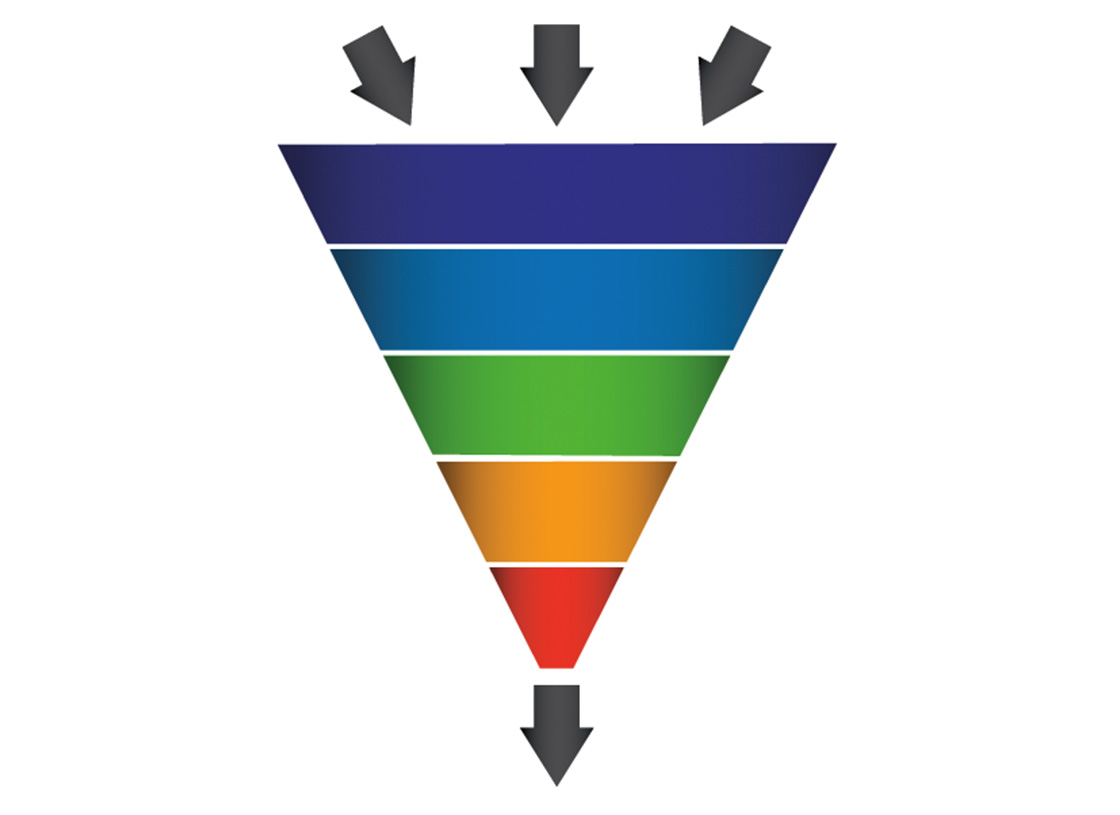Funnel marketing is an overall concept with multiple marketing applications. The idea for the concept always starts wide at the top and narrows as it moves toward the bottom. In this case, getting to the bottom is your goal. That’s the payoff point.
Your marketing campaign, for example, promotes your message in the broadest media (whether TV, radio, newspaper, magazines or SEO strategies). That’s the top of the funnel. After the broad blast, the media begins to get more targeted when it’s placed on billboards in a service territory, in direct mail to neighborhoods in that territory or in social media ads that target specific demographics. The marketing gets even narrower with email to customers in your database and social media posts for your followers.
There are also conversion funnels – which begin when a prospect visits your website, clicks a link and provides an email address. The conversion funnel for marketers is still a series that starts wide (with the visit to a website, possibly thanks to SEO or a follow-up triggered by exposure to other media). And it moves toward the next-step call to action – perhaps “Watch this video series on how to make your home more energy efficient.”
Getting the email address triggers a series of lead-nurturing emails. The emails build a case to schedule an appointment, which eventually leads to an estimate that leads to a closed sale. So, the funnel ends narrow (with a scheduled installation), or even narrower with the enrollment in a maintenance agreement during the installation.
Notably, your database is essential to funnel marketing. You can’t very well bring the conversion funnel to a close without a database that connects the email address with the drip email campaign. You’d be hard-pressed as well to move homeowners from prospect to customer to returning customer to loyal customer without a way of capturing contact info and keeping track of activity.
In a sense, being able to manage your customer data effectively is not unlike taking care of a cash register. Any money that comes into your company comes from your customers. If you lose, misuse or neglect their record, you’re missing out on their future business and your future payment.
Your database is as vital as your service vehicles as the tool you’ll use to move customers from awareness of your company to loyal and referring client. Call-takers and techs should be able to access the history of estimates, service, installation and customer contact, as well as details about systems and age of home. And records should be continually updated any time you have contact with a customer. Be sure to impress on your team the need to capture customer information, including updating cell numbers and email addresses.
The tech on the job may think he’s just trying to get the air back on and head to the next house. But if he defers the necessary for the urgent, he’ll miss valuable data that your company needs to serve the customer. Similarly, he should be able to check the records prior to heading to the home so that he arrives informed and ready to serve.
The more call-takers, techs, installers and estimators know about your customer, the better they’ll be able to help them. This ability to serve at a higher level is also essential to the bottom of the funnel – building a solid relationship with customers that keeps them coming back and referring friends and family. It’s essential as well for maintaining contact through email for customized reminders and upsells specific to purchase history.
Key Takeaways for Creating Customers
Regardless of names and variations, your funnel marketing will go something like so:
The customer has a problem – The marketing funnel begins when customers become aware of a need, concern or question. For example, should they replace their system, should they call for a tune-up or repair or should they cross their fingers and hope for the best? How do they find the right company to solve this problem?
The marketer has an answer – Search engines and an integrated marketing campaign shows customers that you are the contractor they need. They learn this about your company as your media starts with broad reach (billboards, radio, SEM) and becomes more targeted (direct mail, email, social). With each exposure, a prospect is increasingly likely to make contact. If they find you through Google, they recognize your name from other marketing. They typically check your website regardless of the initial message source.
Dripping marketing builds credibility – An email series that deepens customer engagement begins with an automated campaign that is ready to go at initial contact. You get into your customer’s attention span with nurturing content that educates and informs. They move toward installation. If you tighten the connection with retention marketing, eventually you get repeat business and referrals.
The sales funnel or conversion funnel is a companion to the marketing funnel – Prospects gain “awareness” of your company through broad media. They’re in the “interest” stage as they become a lead. You nurture them as they move into the “consideration” stage. They’re in the “intent” stage when it gets real and they’re about to schedule. They’re in the evaluation stage when they’re selecting the best option from your solutions.
Your database helps make this happen – Your database is key to nurturing leads toward the close. It’s also where you’ll keep under lock and key (in the digital form of a secure platform) information that helps serve customers. This information enables a higher level of customer service and the ability to respond to customer concerns more effectively. It’s not just contact information, but service history that can prompt a timely contact – such as a tune-up reminder, upsell or warranty expiration. It’s also how you maintain regular contact through newsletters, postcards and holiday cards that are essential to a solid customer retention program.

